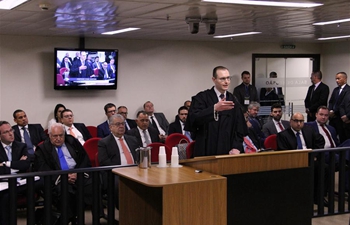CHICAGO, Jan. 25 (Xinhua) -- Light emitted as part of traditional cancer-imaging techniques to locate metastatic tumors can also trigger light-sensitive drugs, according to a study of Washington University School of Medicine in St. Louis.
Researchers at the university found that when such drugs are packaged into nanoparticles that target lit-up cancer cells, the light-sensitive drug produces toxic free radicals that kill the tumor cells, and the technique worked effectively in mice with multiple myeloma, a cancer of white blood cells, and aggressive metastatic breast cancer.
The technology harnesses a chemotherapy drug called titanocene. As a chemotherapy agent alone, titanocene has not worked well in clinical trials, even at relatively high doses. But when exposed to the radiation emitted by visible light, titanocene produces reactive particles that are toxic to cells, even at low doses.
Researchers at Washington University packaged low doses of titanocene inside nanoparticles they targeted to proteins known to sit on the surface of cancer cells, and found that when the nanoparticles make contact with cancer cells, their membranes fuse together, releasing the titanocene into the cells.
They then deliver a common cancer imaging agent called fluorodeoxyglucose (FDG), a type of sugar. Energy-hungry cancer cells take up the FDG at high rates, causing tumors to glow in a positron emission tomography (PET) scan. This glow also triggers the titanocene, releasing free radicals and killing the cells.
As the titanocene and the light-emitting FDG are targeted to the same place at the same time only in tumors, the technique is believed to be less toxic than standard radiation and chemotherapy.
Research also shows that the body rids itself of titanocene through the liver, while FDG is cleared through the kidneys. The fact that the two components are disposed of separately minimizes damage to other organs.
The researchers have tested the strategy on mice with multiple myeloma once a week for four weeks. In the weeks following, the treated mice had significantly smaller tumors and survived longer than the control mice. Fifty percent of treated mice survived at least 90 days, while 50 percent of control mice survived 62 days.
The mice with breast cancer also showed an anti-tumor effect when treated using this strategy, though less pronounced than in those with multiple myeloma, likely due to the extreme aggressiveness of the breast cancer cell line, the researchers said.
The researcher also found that certain types of multiple myeloma were resistant to this technique.
The study has been published online in Nature Communications.

















